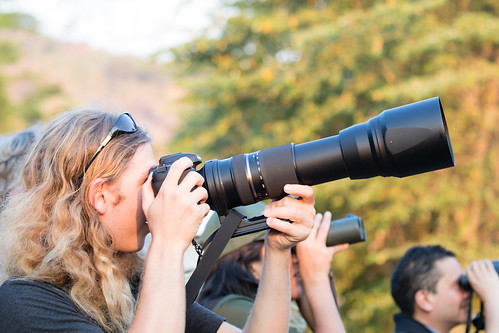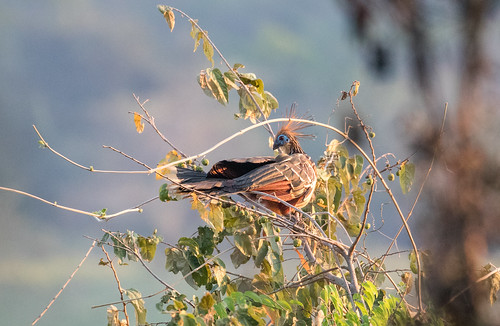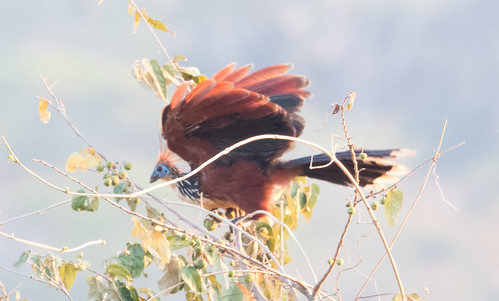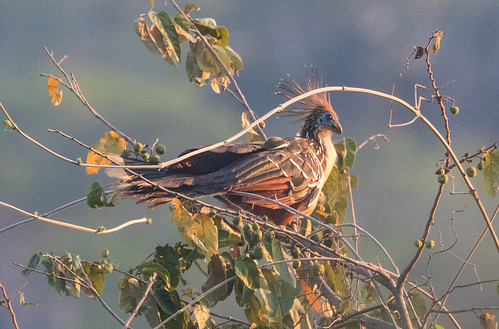
One of the most peculiar of all the birds in the world is also
one of the coolest. The pheasant-sized Hoatzin, a bird of the swamps, riparian
forests, and mangroves of the Amazon and the Orinoco Delta in South America, is
the only species in the family Opisthocomidae, named for the Greek, “Wearing
long hair behind,” referring to the long feathers that form its funky, loose
crest.
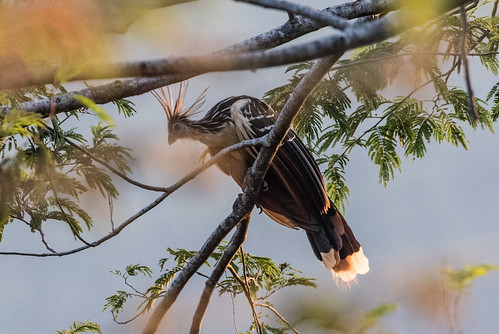

But where this unique family falls in relation to other
birds is still disputed. Right now, the checklist the Cornell Lab of
Ornithology uses places it in the order with cuckoos and roadrunners, but all
kinds of factors, including DNA, keep this under dispute. Some taxonomists
place it as the only member of a unique order, but even they aren’t sure where
to place that order in relation to other orders. It may be somewhat related to
those cuckoos, or to cranes, or to shorebirds, or to doves. The more evidence
we gather about Hoatzins, the more it contradicts evidence we already had, and
the more confused ornithologists grow.
Hoatzins are unique in several ways. Unlike virtually all
birds, they efficiently digest leaves, which comprise over 80 percent of their
total diet. Leaves are far more difficult to digest than just about anything, including
fruits and seeds, thanks to the cell walls that distinguish leafy plant cells
from animal cells.
Cell walls make leaves, by their very nature, harder to digest
than fruits or, once you get through the outer coating or shell, seeds, or any
part of animals. Mammals that digest grasses or other leaves have
specializations. Those rodents that feed on grasses have special grinding
molars; larger mammals that feed on this plant matter digest it through
fermentation. Ruminants such as cows, sheep, goats, deer, and giraffes do this
in their foregut, continually regurgitating portions of food called cud that
they chew all over again. Ruminants have a four-chambered stomach.
Hippopotamuses have a three-chambered stomach. Horses, rabbits, and
rhinoceroses have a single-chambered stomach, but an enlarged and
well-developed cecum—an offshoot of the intestines—where fermentation digests
the cellulose. Then the food returns to the intestines to be digested all over
again.
To allow flight, birds require a light digestive system both
in terms of their internal digestive equipment and in terms of passing all
indigestible food out of their systems as quickly as possible. Only a very few
birds, such as turkeys, chickens, and grouse, have well-developed caeca where fermentation
of leafy matter or woody buds takes place, and these birds have large bodies
and fairly limited, short-distance flight. Nighthawks and their relatives also
have well-developed ceca to help them digest the chitin in insect exoskeletons,
but most of the insect matter they eat is more digestible. The anaerobic
bacteria in any bird caeca make droppings that include caecal wastes extremely
smelly.
Geese feed on grass as well as all manner of more easily
digested plant and animal material. But they aren’t specialized for digesting
grass, so most of it goes in one end and comes out the other, which is why
goose droppings are so very noticeable wherever geese are found. People don’t
realize how lucky we are that geese aren’t specialized for digesting all that
grass, or those copious, slippery droppings would also be horrifically smelly.
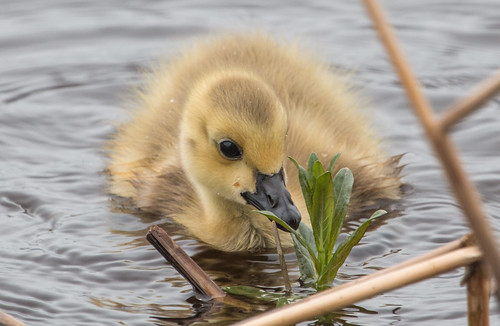 |
| Baby geese can already digest some leaves, but eat more high-protein bugs at first. |
Unlike all other birds, Hoatzins are specialized for
digesting leaves in their foregut by fermentation, in a way fairly similar to
that of mammalian ruminants. Instead of a multi-chambered stomach, Hoatzins
have an unusually large crop, folded in two chambers, and a large,
multi-chambered lower oesophagus. Their stomach chamber and gizzard are much
smaller than in other birds, but their crop is so large that it displaces the
flight muscles and keel of the sternum, making them extremely poor fliers. Fermentation
in that oversized crop is smelly, giving Hoatzins their nickname, the
stinkbird.
When I was working on my ill-fated Ph.D. studying nighthawk
digestion, I took an avian physiology class in the University of Minnesota’s
College of Veterinary Medicine taught by one of the world authorities in avian
digestion, Gary Duke. Our midterm included a few essay questions, one about
bird digestion. In a bolt of whimsy, I titled my answer, “Alimentary, my dear
Hoatzin,” which tickled Gary’s fancy, so he gave me extra credit, making the Hoatzin even dearer to my heart.
If their digestive system weren’t enough to make Hoatzins
exceptional, they are famous for the two claws that young birds sport on each
wing. These well-developed claws help the awkward youngsters scramble through
trees until they get more coordinated. The claws atrophy and disappear as the
young birds mature.
In the tropics, most slow-flying birds the size of Hoatzins
are endangered thanks to excessive hunting, but Hoatzins have a longstanding
reputation for having bad-tasting meat due to the offensive odor of their
digestive system. They also benefit from living in such wet
habitat—deforestation in their range occurs in upland forests that can support
heavy logging equipment, not the wetlands along the Amazon and its tributaries.
So unlike many tropical birds in their range, Hoatzin numbers remain fairly
strong.
Before this month, I’d seen Hoatzins three times, all in
the area around Sacha Lodge in eastern Ecuador along the Rio Napo, back in February
2006. Hoatzins concentrate in the vegetation overhanging rivers, so we saw them
only from boats. The huge birds stayed within the foliage, and in the unsteady
boats, my only photos turned out to be exceptionally poor.


I was extremely hopeful about seeing Hoatzins in Peru, but we
didn’t get out into any rivers by boat, and were only in Amazonia for one day,
at the very end of the long dry season. Everywhere we were, the water levels
were so low that the shorelines had retreated far from the vegetation. A half-hour
before sunset on our final day, as we rode in our bus back to our lodge after
our final birding spot, our guide explained why we hadn’t seen them on this
trip. We were of course disappointed, but I was still basking in the thrill of
having seen a Marvelous Spatuletail and one species we hadn’t expected but that
I’d desperately wanted to see, the Andean Cock-of-the-rock. I reminded myself that it wasn't like the Hoatzin would have been a lifer. We were talking
about how tricky birder expectations are when one birder glancing out the window saw not just one but a whole flock of Hoatzins!
This was a narrow two-lane road,
but our driver managed to turn the bus around and we piled out. And in the subdued
lighting just before our final sunset in Peru, there they were—at least 20
Hoatzins who didn’t seem to mind getting their photos taken at all! What a
magical way to end the final evening of a magical trip.
